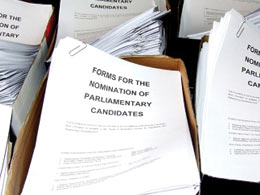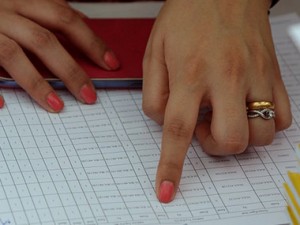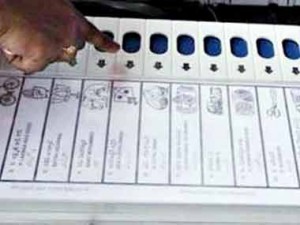In this blog post, Shambhavi Kumar, a student of Jindal Global Law School, Sonipat, provides a brief overview on discrepancies found in nomination papers.

Introduction
The process for seeking election to a legislative body such as the Lok Sabha or the Rajya Sabha starts with the process of filing nomination papers. Nomination papers set forth the details which allow the returning officer to judge whether the person nominated has the qualifications to contest elections. It also provides voters with information about a candidate. In India, anyone can be nominated for contesting an election through nomination papers, provided they comply with the requisite procedure.
Comparing this with the United States of America we find that the use of nomination papers are of two types. Nomination petition and nomination papers. A candidate of a major political party can enter the November election[1] by securing access to the primary ballot, by filing a nomination petition and winning his party’s nomination. Nomination papers, however, are used by candidates of minor political parties or political bodies, which are distinct from political parties, to enter the November election. A nomination paper as used in the United States is similar to the Indian nomination papers having particulars such as the Preamble – stating the name of the minor political party or the political body and the county; Candidate Information; the Signatures of Electors; and the Affidavit of a Qualified Elector affirming the contents of the nomination paper. Nomination papers must be signed by qualified electors totaling 2% of the maximum votes received by a candidate in the previous election.[2] This comparative view shows how cumbersome a process it is even to get nominated in the United States.
In India, this process is a lot easier with a registered political party candidate needing only one proposer and a candidate from a party which is not recognized requiring only ten proposers. This paper will take a brief overview of the nomination process before considering the question of discrepancies in Nomination papers and the effects of such discrepancies.
The Process
An election notification starts the process of filing nomination papers. An election notification is issued calling for the election of representatives from a constituency. As per Section 30 of the Representation of People Act, 1951 (hereinafter The act), the Election Commission must then issue a notification in the Official Gazette laying down the important dates regarding the process of nomination, such as last date of filing nomination papers (7 days from the issue of the election notification), date of scrutiny of nomination, last date of withdrawal, dates of polls and the date of completion of the election process.
The Returning Officer must then give a public notice inviting nominations as per Section 31 of the Act. Section 32 provides that anyone is eligible to be nominated subject to certain caveats. Section 33 deals with the procedure for filing nomination papers. It must be filled containing all the prescribed details and must be submitted to the returning officer at the place designated in the notice issued under Section 31 between 11 pm and 3 pm duly signed by the candidate and proposer or ten proposers in the case of a candidate fielded by an unrecognized party. [3] A candidate can file as many as four nomination papers, and his nomination will be accepted as long as one out of the four is valid.[4]
Role of the Returning Officer and Scrutiny of Papers
The returning officer plays a key role in the process of nomination. He has three major functions concerning the nomination process. He issues a notification inviting nominations under Section 31 as well as specifying the place for submission of nomination papers. He receives nomination papers under Section 33. He scrutinizes nomination papers under Section 36. He has to ensure all nomination papers comply with the provisions of the act, and he has the power to reject nomination papers under certain conditions.
On the date of the scrutiny of nomination papers the candidates, one proposer of each candidate, the election agents and one other person duly authorized by the candidate are the only persons who can be present for scrutiny of nomination papers along with the returning officer. They shall then be allowed to scrutinize the nomination papers of all other candidates. The returning officer decides on all objections brought forward to him or may decide on any discrepancy on his own. He can make a summary inquiry and by such reject the paper on the following grounds:
- Inconsistency with constitutional provisions such as Articles 84, 102, 173 among others.
- Noncompliance with any of the requirements of Sections 33 or 34 of the Act.
- If the signature of the candidate or proposer on the nomination paper is not genuine. [5]
Discrepancies Identified
A discrepancy could be of two types. One so substantial so as to merit rejection of the nomination paper. The other would be typing mistakes, or printing mistakes, or spelling errors or something similarly trivial. A substantial defect warrants rejection. However, a trivial mistake does not.[6] A trivial mistake can be rectified, and the nomination paper can be accepted (Section 33 (4)). However, that is not the case if the discrepancy is a substantial one. Consider incidents of substantial defects.
The omission of age in the nomination paper is a substantial defect.[7] Rejection of nomination of the candidate who name was not found in the electoral role specified in his nomination papers was held to be valid.[8] Omission to mention parliamentary constituency is a defect of a substantial character. The returning officer cannot ignore it and allow it to be corrected. He must reject the paper.[9]
Section 33 B of the Act said that candidates need not disclose any information other than that which is sought by the act. The effect of this was that candidates did not have to submit affidavits regarding criminal cases against them. In Union of India v Assn. For Democratic Reforms,[10] the Supreme Court held that all candidates had to submit affidavits giving detailed information about any criminal cases against them. This right does not come from the statute but the constitution. The people have a right to know this information about a prospective candidate and the statute cannot limit it to Section 33 B. Section 33B was thus held to be ultra vires of the constitution. Thus failure to submit an affidavit regarding criminal cases, or concealing anything about it or giving incomplete information is a substantial defect and grounds to have the nomination paper canceled.
Consider incidents of defects which are not substantial enough to warrant rejection.
Writing now gong, instead of now gone Assembly Constituency in the nomination paper was held to be trivial and not a ground for rejection of the paper.[11] Being nominated by a government servant doesn’t vitiate the nomination paper and the election. [12] The difference in age of candidate in election roll and nomination paper, is not a valid ground for rejecting nomination paper. [13]
These are cases where mistakes were discovered before polling. Consider the cases given below where mistakes were discovered after completion of the election process.
In K. Venkatachalam vs. A. Swamickan and Anr[14] a sitting Member of the Tamil Nadu Legislative Assembly was disqualified owing to a defect in his nomination papers. The appellant, in this case, claimed in his nomination paper that he was a registered voter in the Lalgudi Assembly Constituency of Tamil Nadu. The respondent, however, scrutinized the entire electoral role of the said constituency, and it was discovered that the appellant, Mr. Venkatachalam was not a voter of that constituency. The High Court held him lacking qualifications and liable to be disqualified. The appellant did not dispute this. His only contention was that the High Court could not pass an order under article 226 of the constitution as the matter was time barred under article 329 of the constitution (where election petition is the only remedy available). The Supreme Court here held that this matter came under articles 191 and 193 of the constitution and did not come under Article 329. Here the order of the high court was upheld, and the appellant was disqualified.
In Lila Krishnan v Mani Ram Godara and ors[15],the appellant had her election set aside as legislator of the Fatehabad Constituency in Haryana by the high court on grounds that the respondent’s nomination papers were improperly rejected. The case came before the Supreme Court because of the appeal by the appellant. In the instant case, the respondent in his nomination paper had listed two of his proposers as entry number 126 and 177 in the electoral role. However, the electoral role had the same two people listed at number 26 and 77. What is pertinent to note that the respondent himself, nor his proposer or agents were present at the time of the scrutiny of the nomination papers? The Returning officer noticed the discrepancy between the form and electoral role and rejected the nomination paper. The Supreme Court held that the rejection was valid. Section 33(4) empowers the returning officer to correct typing mistakes and accept the form. Since the respondents were not there to correct the apparent mistake, the returning officer acted correctly in rejecting the nomination papers seeing the discrepancy between the paper and the electoral roll.
Conclusion
Having analyzed the process of filling nomination papers in India, I conclude that it is relatively easy to contest elections in India. Considering the discussion in the paper, the process of nomination is certainly a lot easier in India than it is in the United States of America. The positive aspect of the system in the USA is that only very serious candidates can appear for elections and not too many candidates are thus able to apply. The drawback, however, is that the nature of the process causes the candidate to incur a lot of expenses and thus it makes it very difficult for someone not having a lot of resources to contest elections. The positive part in India is that almost anyone can contest the election, whether backed by a political party or not. The drawback is that sometimes there can be too many candidates for one seat, or many frivolous candidates standing for elections. The process is very fair, however. The process of filling nomination papers provides information on candidates which can be used by voters in making a choice. Similarly, the scrutiny of every candidate’s paper before every other candidate makes the process very transparent, something which is a requirement of any democratic process. Having considered the position in the United States as well as the position in India, I conclude that the nomination process in India is fairer and more desirable for a country like India as it allows every citizen a realistic chance of standing in elections, while being a very transparent process which does not allow any room for discrimination on the basis of means. Whether this leads to free and fair elections for all candidates is a different question altogether.
[divider]
Bibliography
Commentaries
- N. Chaudhary, Election Laws and Practice in India, ( 3rd edn, 2009 Orient Publish Company)
- C Jain And Dr. Kiran Jain, Chawla’s Elections Law and Practice, (8th edn, 2004 Bahri Brothers )
Cases
- Bhom Raj V Devi Singh Bhatti
- Dev Kanta Baroah v Kusharam Nath
- Dharampal Singh v. Jasma Devi
- Venkatachalam vs A. Swamickan And Anr
- Karkrishnalal v Babulal Marandi
- Lila Krishnan v Mani Ram Godara and ors
- Prahlad Dass Khandelwal v. Narendra Kumar Salve
- Raj Krishna Bose v. Binod Kanungo
- Union of India v Assn. For Democratic Reforms
- Viveka Nand Giri v. Nawal Kishore Sahi
[divider]
Footnotes:
[1] Elections to major public posts such as governor, senator, attorney general among others are held in November in the United States of America.
[2] Armstrong County, Pennsylvania, United States of America http://www.co.armstrong.pa.us/departments/public-services/elections-votersregistration/running-for-public-office ( Last accessed on 10th September 2014 )
[3] See R.N. Chaudhary, Election Laws and Practice in India, ( 3rd edn, 2009 Orient Publish Company) 295
[4]See P.C Jain And Dr. Kiran Jain, Chawla’s Elections Law and Practice, (8th edn, 2004 Bahri Brothers ) 1248
[5] See ibid 1259
[6]Karkrishnalal v Babulal Marandi (2003 ) 8 SCC 613
[7]Bhom Raj V Devi Singh Bhatti, AIR 1989 Raj 142
[8]Dharampal Singh v. Jasma Devi AIR 1989 P&H 64
[9]Prahlad Dass Khandelwal v. Narendra Kumar Salve AIR 1973 SC 178
[10] (2002) 5 SCC 294
[11]Dev Kanta Baroah v Kusharam Nath AIR 1961 1125
[12]Raj Krushna Bose v. Binod Kanungo AIR 1954 202
[13]Viveka Nand Giri v. Nawal Kishore Sahi AIR 1984 856
[14] Available at http://indiankanoon.org/doc/1539298/ ( Last accessed 10th September 2014 )
[15]AIR 1985 SC 1073
 Serato DJ Crack 2025Serato DJ PRO Crack
Serato DJ Crack 2025Serato DJ PRO Crack










 Allow notifications
Allow notifications



